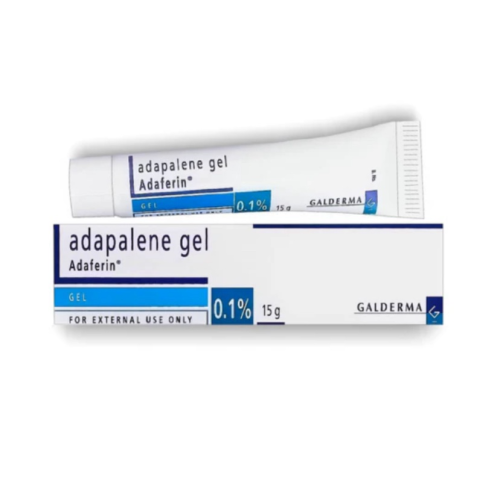Manufacturer: Galderma
Pharmaceutical name: Adapalene
Pack: 1 tube (15 gm (0.1%))
```html
Adaferin Gel is a derivative of naphthoic acid that exhibits pharmacological properties similar to retinoids. It has both modulatory and anti-inflammatory effects. This gel can be utilized as a standalone treatment for mild acne or alongside antimicrobial agents for inflammatory acne, proving effective as ongoing maintenance therapy. Compared to other retinoids, Adapalene acts quickly and has a unique tolerability profile, securing its position in the first-line treatment for acne vulgaris.
Adaferin Gel is a retinoid formulation approved for the topical management of acne vulgaris in individuals aged twelve and older. Acne vulgaris is characterized by the presence of whiteheads, blackheads, and pimples on the skin.
Adaferin Gel should be applied once daily to the affected skin areas after cleansing in the evening before bed. In the initial days of treatment, a noticeable worsening of acne may occur, potentially due to the medication acting on hidden lesions. This reaction should not be a reason to discontinue treatment.
Prior to applying Adaferin Gel, wash the intended area with a non-medicated soap and gently pat it dry. Avoid applying the gel around the lips, eyes, and mouth. Apply a small amount to your fingertips and spread a thin layer over the entire face and other affected skin areas. A mild, temporary sensation of heat and slight stinging may be experienced soon after application. Moisturizers can be used to alleviate irritation or dryness. Patients are advised to limit sun exposure.
Adaferin Gel is for topical application only. Excessive use will not yield quicker or improved results but may lead to significant peeling, redness, or skin discomfort. The gel is contraindicated for those who have shown hypersensitivity to Adapalene or any of its components.
Minimizing sun exposure is crucial during treatment with Adaferin Gel. Patients who are inherently sensitive to sunlight or regularly experience high levels of skin exposure should be cautioned to take care. It is advisable to use sunscreen lotions and wear protective clothing if sun exposure is unavoidable.
Some skin reactions, including dryness, scaling, burning, and erythema, may occur, especially during the first two to four weeks of treatment. These reactions are generally mild to moderate and tend to decrease with continued application. Depending on the severity of these side effects, patients may need to use a fragrance-free moisturizer or decrease the frequency of Adaferin Gel application. If cosmetics are used, they should be non-astringent and non-comedogenic.
The gel should not be used on abrasions, cuts, or sunburned skin.
During treatment, reactions characterized by symptoms such as facial swelling, lip swelling, itching, or eyelid swelling may also be experienced. Patients should discontinue the use of Adaferin Gel and consult a physician if allergic reactions occur.
Some reported side effects include dryness, peeling, erythema, burning, and itching, which are most prominent during the first month of treatment but tend to decrease thereafter. Always consult your doctor if side effects worsen.
Given that Adaferin Gel may cause irritation in some users, caution should be exercised when using it alongside other topical agents (medicated soaps, drying cosmetics, and products containing resorcinol, salicylic acid, or sulfur).
Adaferin Gel contains an active ingredient, Adapalene, which attaches to specific retinoic acid and nuclear receptors but does not bind to the cytosolic receptor protein. The drug functions as a modulator of cellular differentiation, inflammation, and keratinization, though its significance in the context of treating acne vulgaris remains unclear.
Adaferin Gel should be stored in a secure place away from heat and moisture. Do not refrigerate. Keep the medication out of reach of children and pets, and avoid leaving it exposed to the open air.
```
